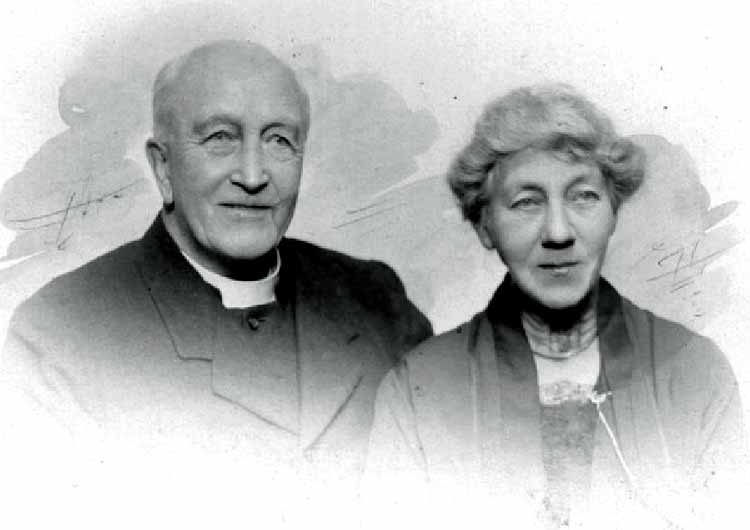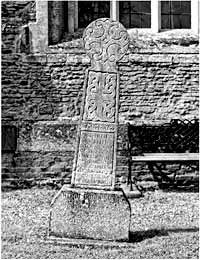Articles from the Thoroton Society Newsletter
Thoroton Society: early members:
Rev. Arthur Du Boulay Hill (1850 - 1938), Thoroton Society member 1897 to 1937
Gertrude Esther Palmer Hill (1849-1934), Thoroton member 1898 to 1925
By Dr Rowena Edlin-White

Arthur Du Boulay Hill and his wife, Gertrude, arrived in Nottinghamshire in 1898 where, on 4th May, he was instituted by Bishop George Ridding, his old schoolmaster at Winchester, as Rector of East Bridgford. His previous post had been Vicar of the “fine old church of Downton,” in Wiltshire, where he had been very happy, but the President of his old College, St. Mary Magdalene, Oxford, which held the patronage of East Bridgford, had offered him the living. Perhaps he was ready for a change, but what now confronted him was likely to prove challenging: “I must confess my heart sank at my first sight of East Bridgford Church... A ruinous porch, and a clerestory with gaping square openings, were almost the only external features visible of any work earlier than the eighteenth century. ‘The windows,’ said the College report... ‘would be considered mean, even in a factory.’” (Hill 183). Nothing daunted, Hill set out to win the hearts and minds of his parishioners, and to share with them his vision for the shabby, neglected church building he had taken on. He describes in his ‘Reminiscences’ (Hill 182-194) how the President of Magdalen College came to East Bridgford at his request on 6th July 1900 to preside at a meeting proposing a scheme for the restoration of the church; and so Hill’s great project began. He knew there had been a church in situ from about 700 AD; it was just a question of finding it. He described the thrill of first seeing the foundations of the Anglo-Saxon chancelarch and wall revealed in 1902; and the pleasure of piecing together “five or six carved stones from a rockery in my garden” which proved themselves to be part of the lost piscina and sedilia, smashed by Cromwell’s soldiers, now put back in their proper place. (Hill p184-5). He was quick to recognise bits of re-purposed “rubble” for what they really were, spotting two pieces of carved stone built into the church walls as fragments of a Saxon cross-shaft. Referring to Thoroton’s History of Nottinghamshire (1677) and Throsby’s new edition in 1790 noting the Puritan vandalism, including that of “a cross-legged figure lying in the churchyard,” Hill says, “The last-mentioned effigy, a crosslegged knight, I was able to rescue from a garden wall at the Hall in 1899. It now lies once more within the Church...” (Hill 138) Every find is acclaimed and, whenever possible, rehabilitated. Hill kept his parishioners up to date with the restoration in the Parish Magazine, keeping them on board with his excitement and enthusiasm. A natural communicator, Hill made sure ‘his’ people were fully informed about all things he felt should matter to them. During this time he was also contributing to Thoroton records and A Nottingham Bibliography lists 18 published items by him about Nottinghamshire churches, the earliest being submitted in 1903 on the subject of St Peter’s Church, East Bridgford. Arthur Du Boulay Hill retired from East Bridgford in 1927. He and Gertrude moved to Dudswell in Berkhamstead, where he spent the next five years writing his book, East Bridgford, Notts. The Story of an English Village (1932), containing all his research over twenty-nine years. I recommend this book; it is hugely readable and never dull; history written with commitment to and affection for a small patch of countryside in the Midlands, and especially its Church. Gertrude Hill deserves a few paragraphs of her own, for she was no ordinary clergy wife, although she did her parish duties. How many of the parishioners knew that from around 1917 she was a member of the Panacea Society, and a devoted disciple of Mabel Barltrop aka ‘Octavia’? For the whole story I refer you to Jane Shaw’s excellent book, Octavia, Daughter of God, the Story of a Female Messiah and her Followers (Jonathan Cape, 2011). Barltrop and her followers formed a community to await the Second Coming - in Bedford. It seems that several of Octavia’s followers were wives, widows or daughters of Anglican clergy.

Gertrude was an early and prominent member who had always pursued her own spiritual path and published a book, “The Story of a Soul’s Awakening”, in 1917. She did try to explain herself to Arthur and even persuaded him to come and meet Octavia; it made him irritable and uncomfortable. Gertrude hoped he might have a ‘Pauline conversion’ and that he would be “for the Work in some ways & probably some great way.” But it was not to be. She wrote to Octavia, “He has said very little about his visit to Bedford. He has scarcely spoken of it but I fancy when next I express a wish to go to you all he will object less. Perhaps not at all.” (Shaw 81-2). They seem to have negotiated a truce. Although ‘sealed’ as a member of the Society in 1919 Gertrude did not move to live in the community, but she continued a faithful Panacean until her death in 1934, when she was taken back to East Bridgford for burial. Arthur would join her there in 1945. Their grave lies under the East window, marked by a somewhat lop-sided Celtic cross; Gertrude’s name is still readable, but Arthur’s, on the plinth beneath, has mostly flaked off could do with a little restoration.
Dr. Rowena Edlin-White
All quotes referenced ‘Hill’ are from ‘East Bridgford, The Story of an English Village’. With thanks to Lynne Black and East Bridgford Local History Group on whose website eastbridgford-history.org.uk may be read the Parish Magazines Arthur Hill edited, as well as other interesting papers and the photograph of the Hills, which I was given permission to use for this article.
< Previous